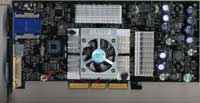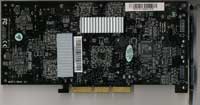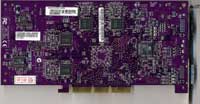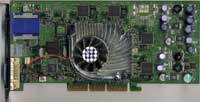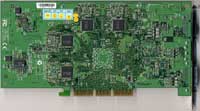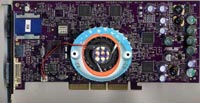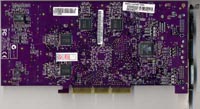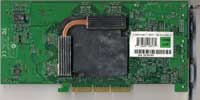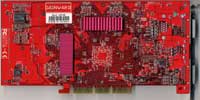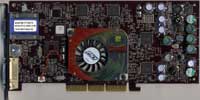
Original Link: https://www.anandtech.com/show/904
NVIDIA GeForce4 Ti 4400/4600 Roundup - April 2002
by Anand Lal Shimpi on April 29, 2002 4:56 AM EST- Posted in
- GPUs
Taking a look back at the past several NVIDIA product launches we haven't been overly positive about any of their flagship GPUs for quite some time. We hounded NVIDIA for bringing an overclocked GeForce2 Ultra to the market in order to meet their self-imposed 6-month product cycles. And while we praised the GeForce3 on a technological level we never recommended buying it as enjoyable DX8 games were clearly months (that turned into years) away from its release. NVIDIA's Titanium nomenclature was first introduced with the GeForce2/3 Ti series and even then we only found it prudent to recommend the GeForce3 Ti 200.
This all changed with the release of NVIDIA's GeForce4 GPU as the Ti 4400 and Ti 4600 models impressed us beyond belief. The performance these two GPUs offered not only in today's games but in other highly anticipated titles was beyond respectable. For the first time we had a graphics solution that could run almost any currently available game at 1600 x 1200 at very smooth frame rates. NVIDIA's new flagship also turned out to be the highest performing solution for Unreal Tournament 2003 and all other forthcoming games based on the latest Unreal Engine. To say the least, we were very impressed with the GeForce4 Ti 4400 and Ti 4600.
Then came the Ti 4200, a GeForce4 for the masses. While Ti 4200 cards are still a couple of weeks away from being in the hands of most retailers, the rest of the GeForce4 line are available in healthy quantities. Although NVIDIA's goal is to ship as many GeForce4 MX cards as possible, to those that know better, it's the real GeForce4 that we're after.
Because of a relative lack of interest in the GeForce4 MX, the existence of the GeForce4 Ti 4200 and as a semi-protest against NVIDIA's misleading nomenclature you won't find a GeForce4 MX roundup on AnandTech. Instead, we've gathered our IR thermometers and rounded up 11 cards based on the GeForce4 Ti 4400 and GeForce4 Ti 4600 GPUs. If you want the fastest 3D accelerator available today, we'll tell you which one fits the bill.
The GeForce4 GPU: Bursting at the Seams
This roundup will not feature regurgitated information from our GeForce4 review, instead we'll point you in that direction if you wish to learn more about the GPU and its performance relative to the competition. There are a few points that are relative to this roundup that we'll mention here in order to help you understand some trends we've been noticing in these cards.
For starters, the GeForce4 GPU is in fact bursting at its seams. The chip is quite expensive to manufacture on a 0.15-micron process and is in desperate need of a shrink down to TSMC's 0.13-micron manufacturing process. Unless NVIDIA decides to release an interim solution between now and this fall (which does have some likelihood of occurring given increasing competition from ATI and other next-gen GPUs being released this summer), the move to 0.13-micron will be made with the NV30. Because of the complex nature of the chip itself and the fact that it's being made on a 0.15-micron process we've noticed relatively little overclocking headroom in the GPUs themselves. In fact we get much better overclocks (percentage-wise) out of the memory on these cards than we do out of the GPUs themselves. Remember that the highest clocked GPUs (Ti 4600) are those that are picked out of the lowest-yielding bins and thus they have the least amount of overclocking potential. But since the GeForce4 is already so complex you shouldn't expect that the Ti 4400 GPUs will overclock just as well as the Ti 4600 parts, these speed bins are kept to very tight margins. We'll talk more about overclocking later in this roundup.
Next on the list of quirks to deal with is that the GeForce4 has no internal TMDS transmitters for DVI outputs. It is an extremely difficult task to integrate TMDS logic onto a GPU die and doing so requires a lot of engineering to insulate the high speed TMDS areas of the die from the rest. This is why you won't find any integrated TMDS transmitters on any of the large/high-speed GPUs. The lack of any integrated TMDS transmitters in the GeForce4 GPU puts the weight of providing DVI support on the shoulders of the card manufacturers. While all of the cards we tested feature at least one Silicon Image 164 transmitter capable of delivering enough bandwidth for a 1920 x 1080 resolution on a flat panel, there was only one card that featured two transmitters allowing for dual DVI outputs. All of the other cards simply provided a single DVI connector and a single analog VGA connector; in most cases a DVI-to-VGA adapter was provided to enable nView support for those that only have analog interface displays.
When the GeForce4 was first released Visiontek was the manufacturer with cards first in the retail channel. They managed to pull this off by following NVIDIA's reference design down to the smallest capacitor and inductor specifications and thus their Ti 4600 cards suffered from the same problem as the NVIDIA reference design. The problem we're speaking of isn't really a fault of NVIDIA or Visiontek, rather of some motherboard manufacturers and their lax adherence to AGP layout specifications.
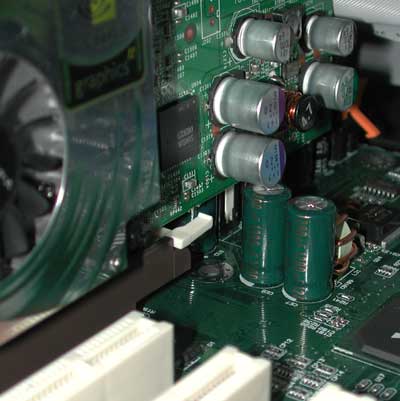
The tall capacitor to the left on the 8KHA+ prevents the Visiontek Ti 4600 from
sitting properly
Our good friends at HardOCP.com first publicized the problem when some of their readers reported that the Visiontek Ti 4600 cards wouldn't physically install in EPoX 8KHA+ boards because of a capacitor on the motherboard that was too tall to clear a capacitor on the video card.
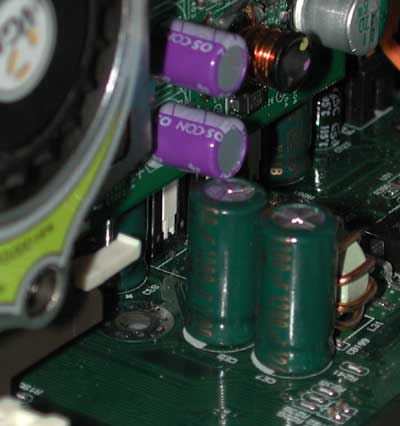
All other GeForce4 cards now use smaller capacitors in this location and thus
fit fine.
It seems as if all of the other manufacturers have learned from Visiontek's unfortunate encounter and have designed their boards around EPoX's poor design by using a smaller capacitor in the offending location.
One of the biggest gripes that users in general have had with third party NVIDIA cards is that they often suffer from poor analog output quality. With the GeForce4 the RGB output voltages leading to the analog VGA output are held with much tighter margins, resulting in better output quality than any prior NVIDIA line. We're still working on a testing methodology to quantify this but if you're happy with the output quality on the Radeon 8500 you'll be fine with these GeForce4 cards.
In terms of what you should look for in a GeForce4 Ti card, once you have decided on the model you'd like (4400/4600) then the biggest consideration should be price. As we've seen in countless prior roundups, these cards will perform very close to one another and unless you're looking for specific VIVO (Video In/Video Out) features, you'll want to go with the card with the lowest price tag.
The Test
|
Windows
XP Professional Test Bed
|
|
|
Hardware
Configuration
|
|
| CPU |
AMD
Athlon XP 2100+ (1.73GHz)
133.3MHz x 13.0 |
| Motherboard |
EPoX
8KHA+ BIOS Revision 3/04/2002
VIA KT266A Chipset |
| RAM |
1
x 256MB DDR266 CAS2 Crucial DIMM
|
| Sound |
None
|
| Hard Drive |
80GB
Maxtor D740X
|
| Video Cards (Drivers) |
All GeForce4 cards used NVIDIA's Detonator 28.32 Drivers ASUS V8460 Ultra
Ti 4600 ABIT Siluro GF4
Ti 4400 |
ABIT Siluro GeForce4 Ti 4400
|
ABIT
Siluro GeForce4 Ti 4400
|
|
| GPU |
NVIDIA
GeForce4 Ti 4400
(275/550 core/memory clock) |
| Memory |
128MB
Samsung 3.6ns DDR SDRAM
|
| Cooling (Core) |
Rectangular
HSF Unit
|
| Cooling (Memory) |
4
- Heatsink Strips
|
| External Video Encoder Chip | |
| External TMDS Transmitter(s) |
1 - Silicon
Image 164 Tx
1 - DVI-to-VGA adapter included |
| Software/Gaming Bundle |
ABIT
SiluroDVD Player
|
| Observed Online Price |
$265.00
|
ABIT has been making NVIDIA based graphics cards for a while now and their Siluro GeForce4 Ti 4400 is another release from the company. There's nothing all to special about the Siluro 4400 outside of its unique cooling setup (you'll hear us say that about a number of the cards in this roundup). ABIT hasn't gone for anything too fancy with this Siluro but at the same time they haven't produced the most effective cooling solution.
The memory heatsinks are attached using a sort of glue which we hope conducts heat well but we fear does more to insulate than conduct. Luckily the GPU itself is covered with a thin layer of thermal grease that provides for ample heat transfer between it and the rectangular heatsink above.
The Siluro 4400 is outfitted with only a single Sil 164 TMDS transmitter meaning that only one DVI output is offered. For those of you without DVI displays, ABIT has provided a DVI-to-VGA adapter so you can utilize both outputs.
The Conexant video encoder chip is identical to the one featured in the Xbox and supports desktop output resolutions of up to 1024 x 768. The single TV-out port on the card is split into a s-video and composite out using a cable provided by ABIT. The card also comes with s-video and composite cables for actually outputting to your TV.
ABIT's only bundled software is their SiluroDVD player software which is simply a re-badged version of WinDVD.
ASUS V8440/TD GeForce4 Ti 4400
|
ASUS
V8440/TD GeForce4 Ti 4400
|
|
| GPU |
NVIDIA
GeForce4 Ti 4400
(275/550 core/memory clock) |
| Memory |
128MB
Samsung 3.6ns DDR SDRAM
|
| Cooling (Core) |
Circular
HSF Unit
|
| Cooling (Memory) |
None
|
| External Video Encoder Chip | |
| External TMDS Transmitter(s) |
1 - Silicon
Image 164 Tx
1 - DVI-to-VGA adapter included |
| Software/Gaming Bundle |
ASUS
DVD2000, Aquanox, Midnight GT Racing, various game demos
|
| Observed Online Price |
$285.00
|
With the V8440 ASUS illustrates the desire for function over form and thus you won't find a single heatsink on any of the eight Samsung DDR SDRAM chips on the card. In fact, any of these cards compared here today can be run without heatsinks on the memory just fine and there are a few manufacturers that set out to prove just that. The GPU however, is a different story; the oddly decorated circular heatsink has a layer of thermal grease between it and the GPU itself which we've found to be very helpful in cooling these GeForce4 cores. While the GPU ran a few degrees warmer than any of the other 4400 cards in the roundup, the memory temperatures were on par with both the ABIT and Visiontek 4400 cards.
The V8440 is outfitted with only a single Sil 164 TMDS transmitter meaning that only one DVI output is offered. Instead of providing a simple DVI-to-VGA adapter, ASUS bundled a strange thing: a DVI-to-DVI/VGA cable. We found it strange because ASUS could have just as easily offered a simply DVI-to-VGA adapter like they do with their Ti 4600 card.
The Conexant video encoder chip is identical to the one featured in the Xbox and supports desktop output resolutions of up to 1024 x 768. ASUS provides a s-video to component adapter cable so you can use the s-video TV out port with either type of cable, but they fail to provide either cable in the box itself.
ASUS has more of a software bundle than most competitors but it also results in a price increase over the rest of the contenders.
MSI G4Ti 4400-VTD (MS-8871)
|
MSI
G4Ti 4400-VTD (MS-8871) GeForce4 Ti 4400
|
|
| GPU |
NVIDIA
GeForce4 Ti 4400
(275/550 core/memory clock) |
| Memory |
128MB
Samsung 3.6ns DDR SDRAM
|
| Cooling (Core) |
Modified
Reference HSF Unit
|
| Cooling (Memory) |
None
|
| External Video Encoder Chip | |
| External TMDS Transmitter(s) |
1 - Silicon
Image 164 Tx
No DVI-to-VGA adapter included |
| Software/Gaming Bundle |
MSI
DVD, No One Lives Forever, Aquanox, Sacrifice, WinProducer/WinCoder,
various demos
|
| Observed Online Price |
$259.00
|
Much like the V8440 we just saw, you won't find any heatsinks on anything but the GPU on MSI's 4400 board. A modified version of NVIDIA's reference GPU heatsink/fan unit is attached via hardened thermal glue and provides excellent cooling. What truly gave the MSI card the edge however was a faster spinning fan that ended up creating an annoyingly loud sound when compared to the other fans. The plus side of this was that the MSI card ended up being the coolest running GeForce4 Ti 4400 out of the entire roundup by a significant margin (you'll see the results in the performance section).
The G4Ti 4400-VTD is outfitted with only a single Sil 164 TMDS transmitter meaning that only one DVI output is offered. Unfortunately MSI does not provide a DVI-to-VGA adapter in the box so you'll have to find one on your own if you want to use nView with dual VGA outputs.
Unlike the other Ti 4400 cards in this roundup, MSI chose to outfit the G4Ti 4400-VTD with a Philips video encoder chip. This particular chip limits output resolution to 800 x 600 but does allow for video input as well as output. In order to take advantage of this MSI bundles a dongle that has four connectors on it: s-video in/out and composite in/out. Only a single s-video cable comes bundled with the card however.
In order to take advantage of the video capture features MSI bundled their card with WinProducer/WinCoder which we have covered in our recent review of ATI's All-in-Wonder Radeon 8500 128MB. As was the case with most of these cards, MSI's DVD player is a re-badged copy of WinDVD. You also get a healthy software bundle with the card at the lowest price out of all the Ti 4400s (it actually tied with the Visiontek Ti 4400).
With the G4Ti 4400-VTD MSI has put together the best balance of features (through their VIVO) and price; our biggest complaint is the lack of a DVI-to-VGA adapter which is quite useful as these cards are perfect for exploiting the benefits of nView.
Visiontek Xtasy GeForce4 Ti 4400
|
Visiontek
Xtasy GeForce4 Ti 4400
|
|
| GPU |
NVIDIA
GeForce4 Ti 4400
(275/550 core/memory clock) |
| Memory |
128MB
Samsung 3.6ns DDR SDRAM
|
| Cooling (Core) |
Reference HSF Unit
|
| Cooling (Memory) |
None
|
| External Video Encoder Chip | |
| External TMDS Transmitter(s) |
1 - Silicon
Image 164 Tx
No DVI-to-VGA adapter included |
| Software/Gaming Bundle |
Cyberlink
PowerDVD & PowerDirector
|
| Observed Online Price |
$259.00
|
What does it take to be the first Ti 4400 to hit the streets? If you have a look at Visiontek's Xtasy Ti 4400 you'll see that it doesn't take much, just a strict adherence to NVIDIA's reference design and strong retailer connections. In fact, as far as availability goes, Visiontek is the easiest out of all of these cards to find which is a definite plus.
As was the case with the ASUS and MSI Ti 4400 cards, the Xtasy Ti 4400 has no heatsinks on its memory and uses the reference NVIDIA heatsink/fan unit attached using thermal glue. The stock setup didn't help this card too much in our thermal tests as it ended up scoring far worse than the top-performing MSI solution. One benefit of this was that the fan wasn't as loud as the MSI unit.
And just like all of the other Ti 4400 cards, there was only a single Sil 164 TMDS transmitter on the board with no DVI-to-VGA adapter provided in the box. The card comes with a sparse software package but at a great price. If you're buying locally then this is probably your own option however if you aren't averse to buying online then you'll be much better off with the MSI card. If Visiontek bundled the card with a DVI-to-VGA adapter we'd be able to recommend this card over the MSI as the cheapest Ti 4400 for those users who only want dual VGA outputs and nothing more.
ASUS V8460 Ultra/TD GeForce4 Ti 4400
|
ASUS
V8460 Ultra/TD GeForce4 Ti 4600
|
|
| GPU |
NVIDIA
GeForce4 Ti 4600
(300/650 core/memory clock) |
| Memory |
128MB
Samsung 2.8ns DDR SDRAM
|
| Cooling (Core) |
Circular
HSF Unit
|
| Cooling (Memory) |
None
|
| External Video Encoder Chip | |
| External TMDS Transmitter(s) |
1 - Silicon
Image 164 Tx
1 - DVI-to-VGA adapter included |
| Software/Gaming Bundle |
ASUS
DVD2000, Aquanox, Midnight GT Racing, various game demos
|
| Observed Online Price |
$385.00
|
Other than the faster GPU and memory there were no physical differences between ASUS' Ti 4600 and 4400 cards. Here's what we said about that card:
With the V8460 ASUS illustrates the desire for function over form and thus you won't find a single heatsink on any of the eight Samsung DDR SDRAM chips on the card. In fact, any of these cards compared here today can be run without heatsinks on the memory just fine and there are a few manufacturers that set out to prove just that. The GPU however, is a different story; the oddly decorated circular heatsink has a layer of thermal grease between it and the GPU itself which we've found to be very helpful in cooling these GeForce4 cores.
The V8460 is outfitted with only a single Sil 164 TMDS transmitter meaning that only one DVI output is offered. Unlike the V8440, this card comes with a simple DVI-to-VGA adapter. The Conexant video encoder chip is identical to the one featured in the Xbox and supports desktop output resolutions of up to 1024 x 768. ASUS provides a s-video to component adapter cable so you can use the s-video TV out port with either type of cable, but they fail to provide either cable in the box itself.
ASUS has more of a software bundle than most competitors but it also results in a price increase over the rest of the contenders.
It's interesting to note that the move to a Ti 4600 raises the average price of the card by exactly $100, keep that in mind when you're deciding on whether to go for a Ti 4600 or Ti 4400.
Chaintech GeForce4 Ti 4600
|
Chaintech
GeForce4 Ti 4600
|
|
| GPU |
NVIDIA
GeForce4 Ti 4600
(300/650 core/memory clock) |
| Memory |
128MB
Samsung 2.8ns DDR SDRAM
|
| Cooling (Core) |
Modified
Reference HSF Unit
|
| Cooling (Memory) |
4
- Heatsink Strips
|
| External Video Encoder Chip | |
| External TMDS Transmitter(s) |
1 - Silicon
Image 164 Tx
1 - DVI-to-VGA adapter included |
| Software/Gaming Bundle |
WinDVD,
Aquanox, MDK2
|
| Observed Online Price |
$319.00
|
By far the shiniest card in the roundup, Chaintech put gold accents on virtually every piece of metal on their Ti 4600. The GPU heatsink, the memory heatsinks, even the DVI and VGA connectors look like Mr. T should be wearing them. It's quickly proven that function should take precedence over form as the shiny elements end up providing the worst cooling out of the batch. As you'll find out later on, this doesn't necessarily mean the poorest overclocking potential but we should make it clear that making your heatsinks look like gold doesn't actually improve anything either.
The only DVI output is driven by the sole Sil 164 transmitter and Chaintech graciously provides a DVI-to-VGA adapter in the box. Chaintech makes the second card we've seen thus far in the roundup with a Philips video encoder chip. The chip allows both video output and input; although Chaintech provides the proper dongle to accept an s-video input they don't provide any video capture software to take advantage of it.
The Chaintech software bundle would have been improved tremendously with software to take advantage of the card's VIVO capabilities but its absence helps result in an extremely low price.
eVGA e-GeForce4 Ti 4600
|
eVGA
e-GeForce4 Ti 4600
|
|
| GPU |
NVIDIA
GeForce4 Ti 4600
(300/650 core/memory clock) |
| Memory |
128MB
Samsung 2.8ns DDR SDRAM
|
| Cooling (Core) |
"Asymmetric
Cooling System"
|
| Cooling (Memory) |
"Asymmetric
Cooling System"
|
| External Video Encoder Chip | |
| External TMDS Transmitter(s) |
1 - Silicon
Image 164 Tx
No DVI-to-VGA adapter included |
| Software/Gaming Bundle |
Cyberlink
PowerDVD
|
| Observed Online Price |
$449.00
|
Every card has a story and this one has a very unique one. The first thing you'll notice about the card is that it features an extremely unique cooling system that eVGA likes to call their Asymmetric Cooling System or ACS for short. The cooling setup is made using two aluminum blocks with grooves cut out of them (one for the front of the card and one for the back). The grooves are then filled with copper piping heatpipes that contain water, these copper pipes are run across the parts of the aluminum heatsink that cover the eight memory chips. The memory chips themselves are attached to the heatsink using thermal tape while the GPU makes contact using thermal grease as usual.
The 5000 RPM fan is noticeably louder than any of the fans on the other Ti 4600 cards but surprisingly enough this elaborate cooling solution doesn't offer any additional overclocking headroom nor any significant cooling improvements. In fact the ACS is more of a novelty feature that results in more noise coming from your system than with any of these other cards. Luckily eVGA offers a similar card but without the ACS for $50 less which ends up being what is sold everywhere online. The problem you run into is that very few of the online vendors differentiate between the ACS equipped card and the card that uses the stock heatsink/fan. Your best bet is to go for the stock version which can be found through most vendors for about the same price as the Chaintech Ti 4600.
There is no DVI-to-VGA adapter included in the retail packaging meaning that the nView support is useless if you have two analog displays and no DVI-to-VGA adapter lying around.
Much like what we saw with Chaintech, eVGA uses the Philips video encoder chip that is capable of video capture operation however they don't include any video capture software; not only that but we don't even get a cable to provide us with the ability to take advantage of the video capture functionality.
Gainward GeForce4 Ultra/750XP
|
Gainward
GeForce4 Ultra/750XP
|
|
| GPU |
NVIDIA
GeForce4 Ti 4600
(300/650 core/memory clock) |
| Memory |
128MB
Samsung 2.8ns DDR SDRAM
|
| Cooling (Core) |
Modified
Reference HSF unit
|
| Cooling (Memory) |
4
- Heatsink Strips
|
| External Video Encoder Chip | |
| External TMDS Transmitter(s) |
2 - Silicon
Image 164 Tx
2 - DVI-to-VGA adapters included |
| Software/Gaming Bundle |
Serious
Sam, WinCoder, WinProducer, WinDVD
|
| Observed Online Price |
$400.00
|
Before we get to the many strengths of Gainward's Ti 4600 we have to point out a serious issue with their card nomenclature. While their GeForce2 & GeForce3 based cards prominently displayed the name of their GPU in the name of the cards themselves, the same cannot be said about Gainward's GeForce4 and GeForce4 MX line. The first problem we had with the naming system is that both the GeForce4 and GeForce4 MX cards carry the same "GeForce4 PowerPack!" name with the only difference between the two lines being that the MX is called a "Pro" while the regular 4 is called an "Ultra." As if that weren't misleading enough, the numbers following the Pro/Ultra have no correlation to the shipping clock speeds of the cards themselves. For example, the Ti 4600 based card is called the Ultra/750XP but the number has no real meaning behind it. The entire community already has issues with NVIDIA's GeForce4/GeForce4 MX naming but Gainward actually further complicates the situation although we're sure that it does help sales a bit.
Having said that, Gainward's card is clearly the most feature-filled Ti 4600 in the roundup. This is the only card with two Silicon Image 164 TMDS transmitters that drive the card's two DVI-I outputs. In order to offer the greatest flexibility Gainward bundles two DVI-to-VGA adapters with the card to allow for two DVI, two analog VGA or one of each type of monitor to be used.
Gainward also uses the Philips video encoder chip and provides all the appropriate cables to allow for both video output and video capturing; and don't worry, all the necessary software is there too. A set of 3D glasses come with the card as well.
As an interesting addition to the bundle, Gainward packages a 3-port Firewire (IEEE-1394) card and a cable with the card. This little gem is presumably to offer a "DV input" for those with DV cameras but in reality you can use the Firewire card for just about anything.
All of these features come at a price and it's a steep one; you'll end up paying around $80 more for this Gainward card than you would a bare GeForce4 Ti 4600 but if you want dual DVI outputs it's the only way to go, short of buying a Quadro4 XGL. Don't forget that for the extra $80 you also get a Firewire card if that's something you can see yourself using.
MSI G4Ti 4600-VTD (MS-8872)
|
MSI
G4Ti 4600-VTD (MS-8872) GeForce4 Ti 4600
|
|
| GPU |
NVIDIA
GeForce4 Ti 4600
(300/650 core/memory clock) |
| Memory |
128MB
Samsung 2.8ns DDR SDRAM
|
| Cooling (Core) |
Modified
Reference HSF Unit
|
| Cooling (Memory) |
None
|
| External Video Encoder Chip | |
| External TMDS Transmitter(s) |
1 - Silicon
Image 164 Tx
No DVI-to-VGA adapter included |
| Software/Gaming Bundle |
MSI
DVD, No One Lives Forever, Aquanox, Sacrifice, WinProducer/WinCoder,
various demos
|
| Observed Online Price |
$352.00
|
MSI's Ti 4600 card is identical to their 4400 board but with faster memory and a higher clocked GPU, here's what we had to say about their 4400:
You won't find any heatsinks on anything but the GPU on MSI's 4600 board. A modified version of NVIDIA's reference GPU heatsink/fan unit is attached via hardened thermal glue and provides excellent cooling. What truly gave the MSI card the edge however was a faster spinning fan that ended up creating an annoyingly loud sound when compared to the other fans. The plus side of this was that the MSI card ended up being one of the coolest running GeForce4 Ti 4600s in the roundup.
The G4Ti 4600-VTD is outfitted with only a single Sil 164 TMDS transmitter meaning that only one DVI output is offered. Unfortunately MSI does not provide a DVI-to-VGA adapter in the box so you'll have to find one on your own if you want to use nView with dual VGA outputs. MSI chose to outfit the G4Ti 4600-VTD with a Philips video encoder chip. This particular chip limits output resolution to 800 x 600 but does allow for video input as well as output. In order to take advantage of this MSI bundles a dongle that has four connectors on it: s-video in/out and composite in/out. Only a single s-video cable comes bundled with the card however.
In order to take advantage of the video capture features MSI bundled their card with WinProducer/WinCoder which we have covered in our recent review of ATI's All-in-Wonder Radeon 8500 128MB. As was the case with most of these cards, MSI's DVD player is a re-badged copy of WinDVD.
PNY GeForce4 Ti 4600
|
PNY
GeForce4 Ti 4600
|
|
| GPU |
NVIDIA
GeForce4 Ti 4600
(300/650 core/memory clock) |
| Memory |
128MB
Samsung 2.8ns DDR SDRAM
|
| Cooling (Core) |
NVIDIA
Reference HSF Unit
|
| Cooling (Memory) |
None
|
| External Video Encoder Chip | |
| External TMDS Transmitter(s) |
1 - Silicon
Image 164 Tx
No DVI-to-VGA adapter included |
| Software/Gaming Bundle |
Star
Wars Starfighter
|
| Observed Online Price |
$325.00
|
Like Visiontek, PNY is mainly a reference board manufacturer. The PNY GeForce4 Ti 4600 is really no different than NVIDIA's reference Ti 4600. There's no cooling on the memory and NVIDIA's reference heatsink/fan unit with PNY's logo on the fan.
PNY follows the example of all too many manufacturers and fails to include a DVI-to-VGA adapter in the box and thus you're stuck with the one VGA/DVI setup if you're interested in using nView at all.
The Conexant video encoder chip is present on the back of the PCB and allows only for video output. The software bundle is small but it helps keep the price down which can definitely be appreciated.
Visiontek Xtasy GeForce4 Ti 4600
|
Visiontek
Xtasy GeForce4 Ti 4600
|
|
| GPU |
NVIDIA
GeForce4 Ti 4600
(300/650 core/memory clock) |
| Memory |
128MB
Samsung 3.6ns DDR SDRAM
|
| Cooling (Core) |
Reference HSF Unit
|
| Cooling (Memory) |
None
|
| External Video Encoder Chip | |
| External TMDS Transmitter(s) |
1 - Silicon
Image 164 Tx
No DVI-to-VGA adapter included |
| Software/Gaming Bundle |
Cyberlink
PowerDVD & PowerDirector
|
| Observed Online Price |
$359.00
|
Visiontek's Ti 4600 board is virtually identical to their 4400 offering with a change in video encoding chips; instead of the higher resolution Conexant chip the Ti 4600 board uses the Philips chip which supports lower output resolution but does allow for video capture support. This is where the bundling of Cyberlink's PowerDirector comes in handy.
Visiontek provides a dongle that splits the single port on the card into a s-video input and s-video output but once again we get no DVI-to-VGA adapter.
Gaming Performance - Unreal Performance Test 2002
As we mentioned at the start of this review, these cards will end up performing very close to one another and thus you shouldn't put much weight on the performance scores you'll see here. Because all of the scores were virtually identical we only chose one benchmark at one resolution, and of course we picked the best benchmark of them all - the Unreal Performance Test 2002. With the release of UnrealTournament 2003 rapidly approaching, this benchmark is more important now than ever before.
|
As expected the cards within a given family all perform within 2% of one another. We threw in the Ti 4200 score to illustrate the performance difference between the 4400/4600 and the 4200 just in case you were wondering what you're paying extra for. Here, the 4600 is 25% faster than the 4200 and the 4400 is about 14% faster.
Cooling Performance
In order to test cooling performance and efficiency we used a Radio Shack IR Thermometer and took the temperatures of the cards while running a 10 minute loop of the Unreal Performance Test 2002. The GPU temperature was recorded from directly behind the GPU on the PCB and the memory temperature was recorded from behind the same memory chip on each board, once again on the back of the PCB. The highest sustainable temperature was recorded during the 10 minute period.
|
It's always good to see that it's not always the most elaborate cooling solutions that end up doing the best. If you recall, the most bells and whistles belonged to the eVGA Ti 4600 yet it was one of the worst in terms of cooling performance.
|
Once again we see that the best cooled memory is that which doesn't have a poorly designed heatsink on it. The two coolest Ti 4600 and Ti 4400 cards both fail to use any heatsinks on their memory yet they perform at the very top of the pack.
Summary Table
|
GeForce4
Ti 4400 Card Comparison
|
|||||||
| Card Name |
GPU
Temp (°F)
|
Memory
Temp (°F)
|
GPU
Overclock (MHz)
|
Memory
Overclock (MHz)
|
Overclocked
GPU Temp (°F)
|
Overclocked
Mem Temp (°F)
|
Avg.
Online Price
|
|
ABIT
Siluro GF4 Ti 4400
|
151.5
|
120.5
|
300
|
660
|
158.5
|
122.5
|
$265
|
|
ASUS
V8440 Ti 4400
|
155.0
|
120.0
|
290
|
660
|
160.0
|
122.0
|
$285
|
|
MSI
GeForce4 Ti 4400
|
143.5
|
115.0
|
310
|
640
|
148.5
|
116.5
|
$259
|
|
Visiontek
Xtasy GeForce4 Ti 4400
|
153.5
|
119.5
|
320
|
680
|
160.5
|
124.5
|
$259
|
|
Average
|
150.9
|
118.8
|
305
|
660
|
156.9
|
121.4
|
$267
|
The important numbers to look at here are the averages since that will give you a better idea of where these things can overclock. What's most important to take away from this table is that, on average, we were able to overclock our Ti 4400 cards to higher than the stock speed of the Ti 4600. If you then look at the average selling price of the Ti 4400 and compare it to the Ti 4600 prices below you'll see how economical it is to overclock and stick with the Ti 4400.
|
GeForce4
Ti 4600 Card Comparison
|
|||||||
| Card Name |
GPU
Temp (°F)
|
Memory
Temp (°F)
|
GPU
Overclock (MHz)
|
Memory
Overclock (MHz)
|
Overclocked
GPU Temp (°F)
|
Overclocked
Mem Temp (°F)
|
Avg.
Online Price
|
|
ASUS
V8460 Ultra Ti 4600
|
146.5
|
119.0
|
320
|
720
|
151.5
|
121.5
|
$385
|
|
Chaintech
GeForce4 Ti 4600
|
163.5
|
130.0
|
330
|
730
|
168.5
|
133.5
|
$319
|
|
eVGA
e-GeForce4 Ti 4600
|
161.0
|
123.0
|
300
|
730
|
161.0
|
126.0
|
$449
|
|
Gainward
GeForce4 Ultra 750XP
|
152.5
|
120.5
|
320
|
740
|
155.5
|
122.5
|
$400
|
|
MSI
GeForce4 Ti 4600
|
147.5
|
117.5
|
320
|
730
|
151.5
|
119.0
|
$352
|
|
PNY
GeForce4 Ti 4600
|
156.5
|
126.5
|
300
|
730
|
156.5
|
128.5
|
$325
|
|
Visiontek
Xtasy GeForce4 Ti 4600
|
155.0
|
123.0
|
320
|
730
|
159.0
|
127.0
|
$359
|
|
Average
|
154.6
|
122.8
|
315.7
|
730
|
157.6
|
125.4
|
$370
|
While we get great headroom out of Samsung's 2.8ns memory, the NV25 GPU is pretty much stuck at 320 - 330MHz.
Overclocked Performance
|
When you overclock the cards the biggest difference can be had with the Ti 4400 cards which generally gain a 10 - 12% performance boost; the Ti 4600 cards were limited to just under a 10% gain.
Final Words
With the GeForce4 NVIDIA truly has a winner and that makes the jobs of the card manufacturers much easier. Without a single card currently available that can touch the performance of either of the solutions featured here today, if you want the best of the best the choices are right here in front of you.
If you flip back a few pages to our summary tables you'll realize that we didn't pick our roundup winners based on overclocking stats, temperatures or performance. In the end, the cards with the coolest running temperatures didn't overclock any better and the cards with the highest overclocks didn't have the most robust cooling setups either. The reason behind this being that the hardware was truly the limiting factor, especially in the case of the GPUs. Since all the memory is sourced from the same manufacturer (Samsung), the overclocking characteristics are really identical across the entire line of GeForce4 cards at this point. In fact, this comparison gives us a better idea of how the Samsung BGA memory chips overclock as its a larger sample size than we've taken in any individual memory comparison before.
The primary deciding factors for issuing our Editor's Choice awards here were price/availability and features/bundle. Because the two are generally mutually exclusive unless you obtain a good balance we made recommendations on best value and best overall package as well.
| As the best overall GeForce4 Ti 4400 card, our Editor's Choice Silver award goes to MSI for the G4Ti 4400-TVD. MSI would have won the gold had they included a DVI-to-VGA adapter but other than that oversight the card is as good as it gets when it comes to Ti 4400 solutions. |  |
 |
As the most feature-filled GeForce4 Ti 4600 card, our Editor's Choice Gold award goes to Gainward for the GeForce4 Ultra/750XP. It's the only card that offers dual DVI outputs as well as such a healthy feature-set. However we would like to see Gainward drop their confusing naming scheme as their products are strong enough to stand on their own without confusing marketing being thrown in there. |
| Coming away with our Editor's Choice silver award for the best GeForce4 Ti 4600 is PNY with their card. If you don't care about the features that the Gainward card offers then the PNY is approximately the same cost as the Chaintech but without the incubating heatsinks and you get much wider spread availability. |  |
There you have it, if you're in the market for a GeForce4 Ti 4400 or Ti 4600 you should have everything you need to make an educated buying decision. Next up on the list, a roundup of the highly anticipated GeForce4 Ti 4200 cards as soon as they're available. Stay tuned.

